How To Get Rid Of Boils Fast?
Boils are bumps (both painful or painless), which may appear on virtually any part of your body, including scalp, face, neck, nose, armpit, inner thigh or bottocks. This detailed post looks at medical and home remedies for treatment of boils to get a fast relief. Pictures included.
What are boils?
A boil is a painful bump or skin abscess full of pus that appears under the skin. A collection of boils that appear together is known as a carbuncle. Boils develop when bacteria infect hair follicles and the hair follicles swell up. People with weak immunity, teenagers, and young adults are more prone to boils than children or older adults.
Skin specialists say that you should not try to squeeze or burst boils on your own. They generally disappear themselves after a couple of weeks without any therapy. If they cause severe pain, last longer than two weeks, or are accompanied by high body temperature, you should consult your doctor.
Boils can appear on any area of the skin with hair follicles. They most often appear in sites that face friction, or where the skin is sweaty. For instance, they may appear on the face, neck, arms and armpits, around the anus, on inner thigh and even on buttocks. The appearance of a boil in the ear canal can be very painful.
Who is at risk of developing boils?
You are more likely to get boils:
- If you are suffering from some other skin ailment that causes itching and irritation such as eczema
- If you are extremely obese or overweight
- If you have a weak immune system
- If you are frail or weak due to some illness
- If you are a carrier of staphylococcus bacteria.
Types of boils
Boils can be classified into the following types:
Carbuncle or furuncle
A furuncle is a single pus filled boil under the skin usually caused by the activity of the bacterium Staphylococcus aureus. It may have none to multiple openings into the skin and sometimes causes fever or chills. A carbuncle is a "collection" of furuncles (e.g. several merged furuncles). Therefore they are usually larger than furuncles and more serious. Furunculosis is a condition, in which multiple furuncles appear on multiple locations.
Here is a picture explaining the difference with furuncle, carbuncle and furunculosis:
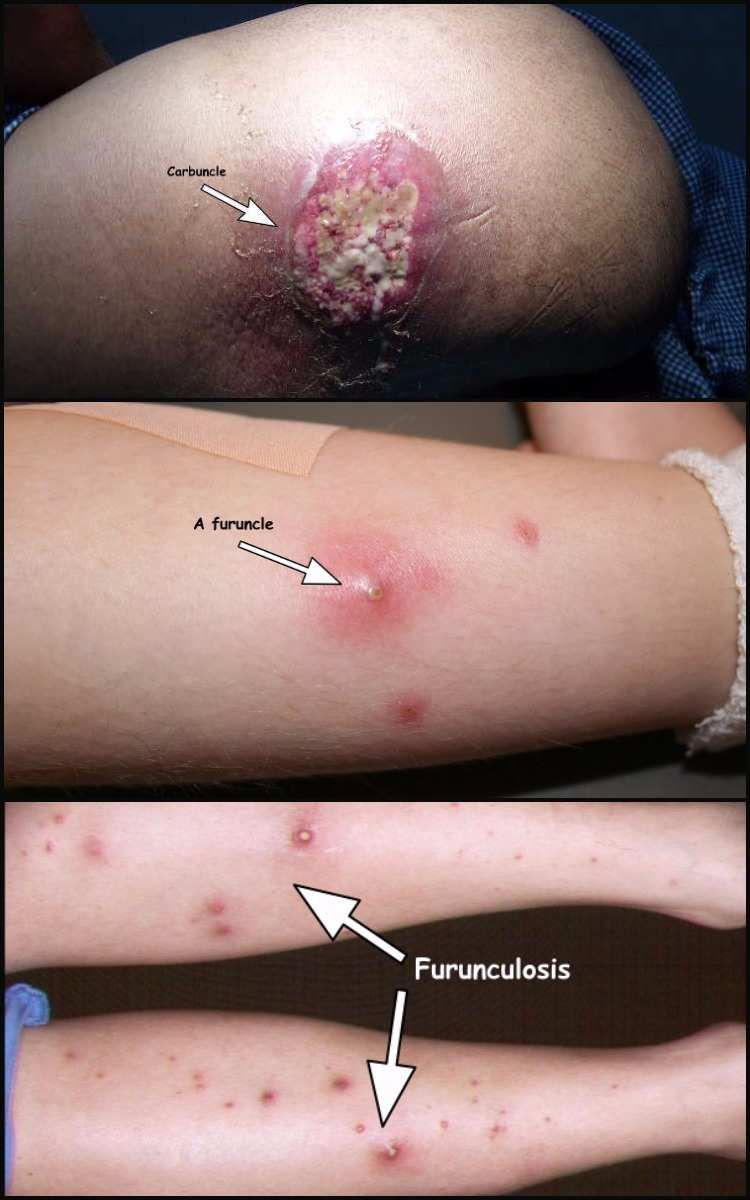
Cystic acne
This is a type of boil that forms when oil ducts become infected and blocked. Cystic acne frequently appears on face, especially in teenage years.
Hidradenitis suppurativa
These boils appear usually under armpits and in the groin area. These boils are caused due to local inflammation of the sweat glands. This skin ailment is hard to treat with antibiotics alone and often requires a surgical procedure to remove the sweat glands involved.
Pilondial cyst
Pilondial cyst mostly appears on the crease of the buttocks. It develops as a small infection of the hair follicle. After a while, it becomes inflamed and causes pain on sitting. Usually, it appears after a long journey.
Symptoms of boils
In its initial stages, a boil appears as a pinkish-red, tender, swollen pustule on a firm area of the skin. Over time, it turns into a water-filled cyst or balloon.
Pain increases as the boils become filled with dead tissue cells and pus.
The main symptoms of a boil are:
- A pea-sized bump, it may become as large as a golf ball
- Whitish-yellow center of pustules
- May spread to adjoining skin areas
- Rapid growth
- Oozing, weeping and crusting.
Less frequent symptoms may include:
- Exhaustion
- High temperature
- General feeling of illness
- Itching
- Skin becomes tender and red
Causes of boils
The main cause behind boils on skin is infected hair follicles. This infection may happen due to a number of reasons:
- Poor diet and malnutrition (deficiency of vitamin A or E especially)
- Chafing of clothes
- Disturbed hormonal levels
- Clogged sweat ducts that become infected
- Mental worry
- Weak immune system
- Being diabetic
- Autoimmune diseases
- Obesity
- Polycystic Ovarian Syndrome (PCOS)
- Dental decay
- An ingrown hair
- Trauma to skin (for example a splinter piercing the skin or an infected tattoo)
- Poor hygiene
How to treat boils with evidence based medical treatment options?
Before we start here is an important warning!
Never try to cure boils at home! Always see your dermatologist (e.g. skin doctor) to get a proper treatment. Before you attempt using home and natural remedies to deal with your boils always see a dermatologist and ask him/her for prior consent! Untreated or wrongly treated boils can lead to serious health issues!
Draining boils
If you have large boils with a spongy surface (the medical term for this type of boil is a fluctuant boil) contact your doctor. This is because when a boil becomes tender and spongy, it's unlikely to disappear on its own and probably can’t be treated effectively with antibiotics.
You will have to get pus drained by your doctor by a procedure called incision and drainage. In some cases, your doctor might refer you to the nearest hospital for getting this procedure done.
In incision and drainage, the tip of the boil is pierced with a scalpel or sterile needle. This causes drainage of pus from the boil, which helps reduce pain and stimulates the recovery process.
Before the actual procedure, you will most probably be given an anesthetic to numb the pain.
Do not attempt to pierce or burst a boil yourself because this can exacerbate the infection.
Antibiotics
Antibiotics are usually recommended for cases where:
- In patients who have carbuncles
- If you experience high fever
- If a secondary infection, cellulitis (infection of deeper layer of skin) develops
- If a boil appears on facial area – facial boils are more prone to causing complications
- If you experience severe pain and discomfort
- Doctors usually prescribe a week long course of a penicillin-based antibiotic called flucloxacillin. If you are allergic to penicillin, you can use other antibiotics, such as erythromycin and clarithromycin.
You should complete the course of antibiotics even after the boil goes away, otherwise, the infection could come back.

These antibiotics are used to treat boils:
- Amoxicillin
- Cefaclor
- Ampicillin
- Sodium Fusidate
- Nitrofurazone
- Povidone Iodine
- Nitrofurazone
How to get rid of boils with home remedies
Home remedies may provide you with some relief but they should never be used alone and you should always get a proper medical treatment and try home remedies only as a complementary treatment and with prior consent of your physician.
While some people claim that natural medicine is cheaper and safer than clinical treatment and home remedies come with minimum side effects, wrongly treated boils can lead into serious health issuer or even death!
Here is a detailed overview of 26 home remedies for treatment of boils, including detailed instructions on how to use each remedy.
Warm compress
Warm compress speed heals boils rapidly by softening and bursting them. This process aids in pulling the pus to the surface of the skin and reduces pain as well. The boil will heal faster if you add salt to the compress.
You will require:
- Fifteen to sixteen cups of warm water
- One teaspoon salt
- A gentle soap
- A clean washcloth
Instructions:
- Wash the boil and the skin around it using mild soap and water.
- Mix in salt with warm water and stir well.
- Soak the washcloth in salty water and wring out excess water.
- Place the soaked washcloth over boils and affected skin area.
- Leave it on for about ten to fifteen minutes.
- Repeat this process three or four times daily for best results.
Continue this process for a week or ten days until your boils heal.
Indian lilac or neem
Neem or Indian lilac (Azadirachta indica) is a popular ingredient in Ayurvedic medicine, Unani owing to its multiple medicinal properties. All parts of the Indian lilac tree are used for medicinal purposes. Its leaves particularly have antiulcer, antiviral, antioxidant, anti-inflammatory, anti fungal, antimalarial, antibacterial, anticarcinogenic traits that are helpful in curing many health conditions such as fever, infections, inflammation, dental problems, and skin related conditions including boils.
You will need:
- Leaves from neem or Indian lilac tree
- Water
Directions:
- Crush a handful of Neem leaves and mix the powder with water to prepare a paste.
- Apply this paste to affected skin areas.
- Leave it on for about ten to fifteen minutes.
- Wash it off.
Or you can:
- Boil two glasses of water and add in neem leaves to boiling water.
- Boil until half of water evaporates.
- Remove from stove and let it cool down for a while.
- Wash skin affected with boils with this water.
Repeat this process regularly for optimum results.
Turmeric
Turmeric may be extremely effective when it comes to treating boils due to its potent anti-finlammatory properties.
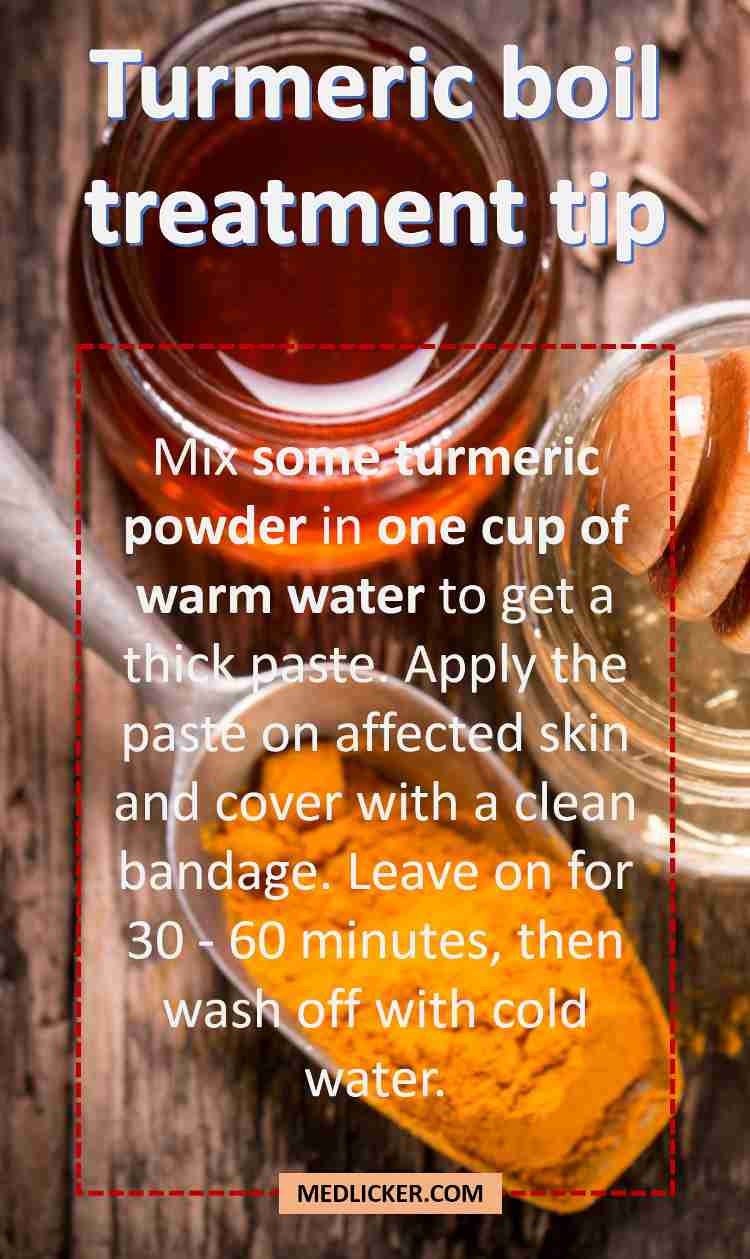
It is a spice used in traditional Indian and Chinese medicinal systems and it is obtained from the curcuma longa roots.
Method #1
You will need:
- One teaspoon of turmeric powder
- One cup warm water or milk
Instructions:
- Mix turmeric powder in milk or water.
- Drink this mixture three times a day for best results.
Method #2:
You will require these ingredients:
- Water
- Some turmeric powder
- A gauze or bandage
Instructions:
- Prepare a paste by mixing turmeric powder in water.
- Apply this paste to affected skin area.
- Cover with a clean bandage.
- Leave it on for half an hour.
- Wash off with water.
Repeat this process regularly for best results.
Note: You can add ginger, curd or basil leaves for best results.
Method #3:
You will need these ingredients:
- Turmeric root
- A coarse stone
- Water
Process:
- Boil some water and soak turmeric root in this hot water for three-five minutes.
- Rub the root over coarse stone with water to obtain a paste
- Dab the paste over your boils
- Allow the paste to dry
- Wash it off with water.
Repeat this process regularly for obtaining best results.
Method #4:
Ingredients:
- Turmeric paste
- Water
- Curd
- Mild soap
Instructions:
- Mix turmeric powder, curd, and water to prepare a paste.
- Wash the area with boils gently and pat it dry.
- Apply turmeric curd paste on boils, especially before a bath.
- Allow it to dry for a few minutes.
- Wash it off with mild soap and water.
Use this remedy regularly to get rid of boils.
Method #5:
You will need:
- Turmeric
- Some ginger
- A clean cloth
Directions:
- Combine and blend equal quantities of turmeric and fresh ginger to make a paste.
- Dab this paste on boils and surrounding skin area.
- Cover it with a clean cloth and leave the paste on for about half an hour.
- Wash it off with some warm water.
Repeat this process regularly.
Method #6:
You will need these items:
- Turmeric powder
- Water
- Handful of basil leaves
Process:
- Blend some fresh basil leaves and extract their juice.
- Add some turmeric powder to this juice.
- Apply this paste over affected areas of skin, especially if boils appear on buttocks.
Repeat this process three to four times every day to achieve relief from boils.
Tea Tree Oil
Tea tree oil is obtained from the Melaleuca Alternifolia tree native to Australia and it has antifungal, antiseptic, antimicrobial, and antibacterial properties that help treat boils effectively.
You will need these ingredients:
- Tea tree oil
- Mild soap
- Water
- Elastic bandage
- Cotton
Instructions:
- Rinse the area of skin affected by boils using mild soap and water.
- Use a clean cotton ball to gently dab tea tree oil over boils.
- Cover the affected area with the elastic bandage.
Repeat this process three times a day for best results.
Note: If you have sensitive skin, dilute the oil in some water before use to avoid skin irritation.
Potatoes
High amounts of iron, iron, phosphorus, vitamin C, magnesium, manganese, B – complex vitamins are present in potatoes and they are helpful in treating many health conditions and skin-related problems. Potatoes also contain tannins, flavonoids, and alkaloids that boost overall skin health.
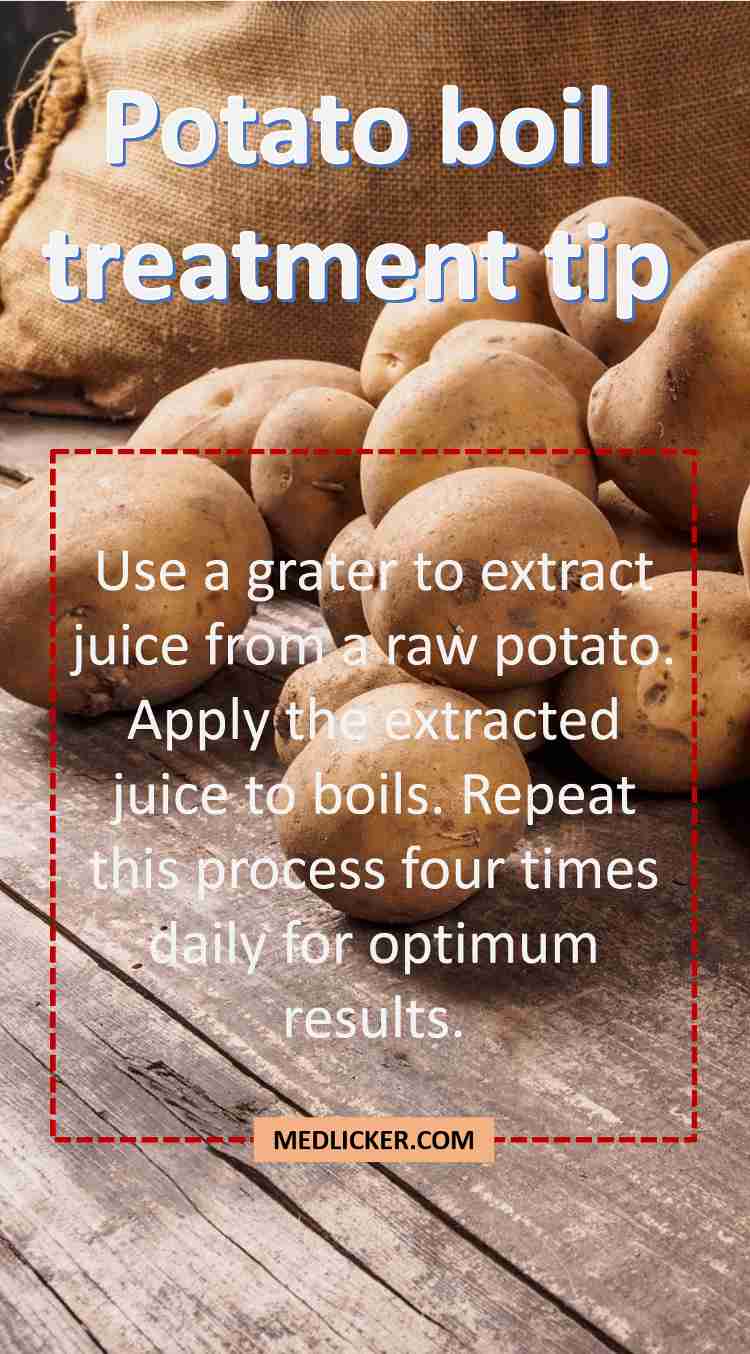
They have anti-inflammatory properties and alleviate pain caused by boils.
Method #1:
You will need:
- A potato
- A knife
Directions:
- Cut the potato into thin slices using a knife.
- Place the potato slices on affected skin area.
- Leave them on for a few minutes.
- Cut some fresh slices and replace the old ones.
Repeat this process two times every day for best results.
Note: You can use this remedy at night before going to bed by placing slices on the affected area and cover the area with a clean cloth or bandage and leave overnight for best results.
Method #2:
You will need these ingredients:
- A potato
- A grater
- A wad of cotton
Instructions:
- Use a grater to extract juice from a raw potato.
- Apply the extracted juice to boils.
- Repeat this process four times daily to obtain optimum results.
Onion
Onions contain twenty active compounds such as potassium, flavonoids, and salts that have anti-inflammatory properties that alleviate pain. Onions have essential oils that have antifungal, expectorant, antiseptic, analgesic and anticoagulant traits which help treat and prevent boils.
Onions, particularly red onions, eradicate toxins, cleanse wounds, and provide relief from skin inflammation. Onions boost circulation of blood and suck out the pus from boils.
You will need:
- A large onion
- A clean bandage or cloth
Instructions:
- Chop an onion into slices.
- Put the onion slices over the affected area.
- Cover with a clean bandage or cloth.
- Replace this onion poultice with fresh slices for every three to four hours for few days.
- Repeat this process daily for achieving best results.
OR you can also:
- Cut the onion into slices.
- Boil the onion slices in water until half of the water evaporates away.
- Use this onion liquid to wash the area with boils for added results.
Epsom salt
Epsom salt, also known as Magnesium sulfate, is a useful home remedy for curing boils.
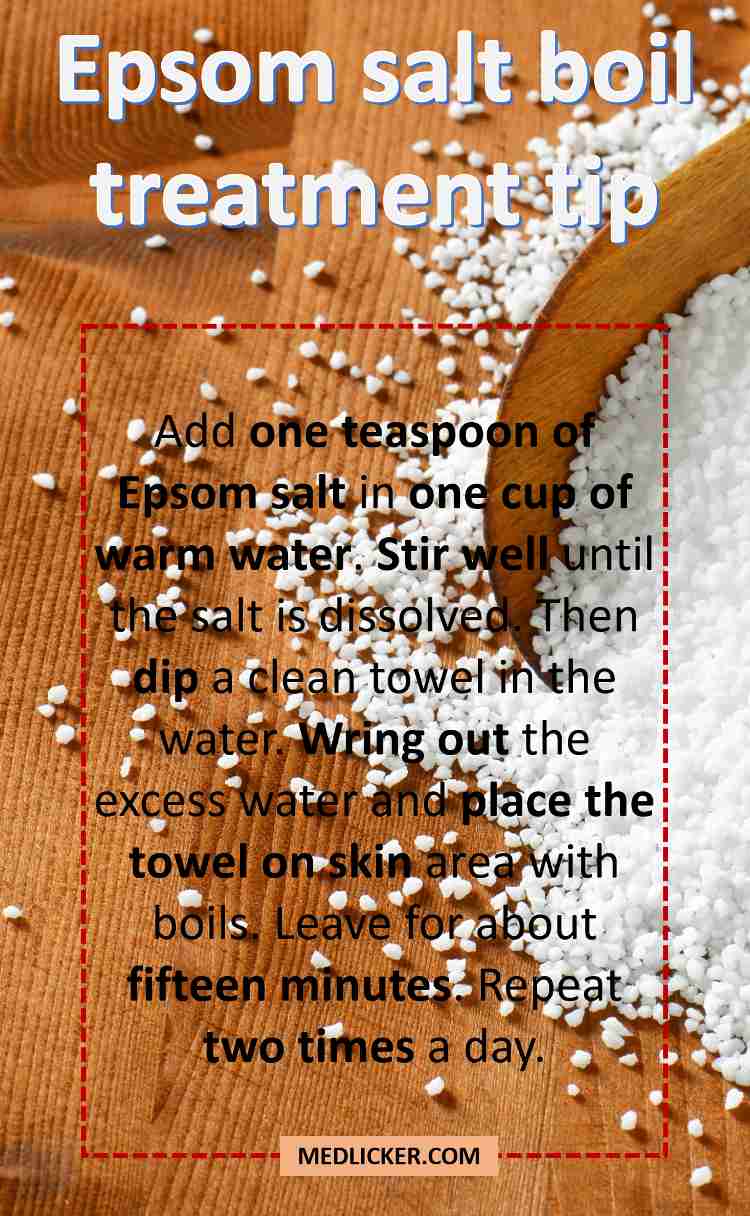
Epsom salt is a drying agent that helps in drawing out toxic pus from boils, reducing swelling and relieving pain.
Method #1:
You will require these things:
- Two cups of Epsom salt
- Warm water
- A small tub or basin
Directions:
- Fill a small basin or tub (sink) with warm water.
- Add two cups of Epsom salt
- Soak the affected area in this Epsom bath for about half an hour
- Allow the affected area to dry on its own
- Soak daily in Epsom bath to get rid of boils
Method #2:
You will need:
- One teaspoon Epsom salt
- One to two cups of warm water
- A clean washcloth
Instructions:
- Add Epsom salt into water.
- Stir well until salt is dissolved and dip clean washcloth or towel in the water.
- Wring out the excess water and place the cloth on the area with boils.
- Leave the cloth on for about fifteen minutes.
- Repeat two times a day to get rapid relief.
Garlic
Garlic contains high deposits of sulfur and has substances such as allicin and ajoene which help treat boils. It also has anti-bacterial, antibacterial and antiviral properties that make it an ideal home remedy for treating boils. Simply adding garlic to your diet will help in curing boils. Include garlic in your daily diet for additional results.
Method #1:
You will need:
- Two to three garlic cloves
- Water
Follow these steps:
- Crush the garlic cloves and mix water to make a paste.
- Apply this garlic paste to the area with boils.
- Leave this paste on until it dries.
- Wash it off with water.
- Repeat this process daily to cure boils.
Method #2:
You will need:
- One or two garlic cloves
- A clean washcloth
Instructions:
- Heat garlic clove until it is warm. It should not be too hot.
- Apply the clove to the affected area and cover with the washcloth.
- Leave it on for about fifteen minutes.
- Repeat two times daily for best results.
Bread poultice
Bread is a used to treat various skin ailments such as pustules and boils. A bread poultice draws out toxins from the skin and it helps our skin heal rapidly. It soothes irritated skin as well. This process decreases inflammation and disinfects skin.
You will need:
- One or two slices of bread
- Warm water or milk
Instructions:
- Soak slices of bread in warm water or milk.
- Apply this poultice to the affected area.
- Leave it on for ten minutes.
- Apply this remedy twice daily for best results.
Black seed oil
Black seed, widely known as black cumin, is obtained from the Nigella Sativa plant and has been used in South Asian and Middle Eastern countries for various therapeutic purposes. Black cumin is rich in nutrients and its oil has antioxidant, bactericidal and anti-inflammatory qualities that boost the strength of immune system.
Research has found that black cumin contains an active constituent called Thymoquinone which has fungicidal properties and it effectively treats skin infections.
You will need these things:
- Half teaspoon of black seed oil
- A hot or cold beverage
Follow these steps:
- Add black cumin oil to any cold or hot beverage and mix well.
- Drink this mixture twice daily to get relief from boils.
Milk
Milk pulls out the pus from the boils, speeds up the healing process and provides instant relief from pain.
Method #1:
You will need:
- A cup of milk
- Two to three teaspoons of salt
- Crumbs of bread or flour
Instructions:
- Heat milk on a stove and slowly add in salt.
- Stir well and add flour or bread crumbs.
- Apply this mixture to the area with boils.
- Leave it on until it dries.
- Wipe it off using a clean towel and rinse with water.
- Repeat this process two times a day for best results.
Method #2:
Both milk and cream are a useful home remedy for curing skin boils.
Ingredients:
- One teaspoon of milk cream.
- One teaspoon vinegar.
- A teaspoon of turmeric powder
Process:
- Mix milk cream, turmeric powder and vinegar in a bowl.
- Apply this mixture to the affected area.
- Leave it on until dry.
- Wash it off with water.
Echinacea
Echinacea is a herb that has many medicinal properties. It directly blocks the action of the staphylococcus aureus, a bacterium active in the development of boils.
You will need:
- Echinacea
- Pasque flower
- Wild indigo
- Some water
- A teapot
Instructions:
- Steep a teaspoon of Echinacea powder in a teapot filled with water for about fifteen minutes.
- Strain it and drink this concoction two times daily.
- You can also steep some powdered Echinacea, Pasque flower and wild indigo in hot water.
- Strain and drink this liquid twice daily.
- You can also apply this tea directly on the affected area.
Note: Pregnant or nursing women should not use this herbal remedy.
Cornmeal
Cornmeal doesn’t actually have medicinal traits but is a natural absorptive agent that makes it a perfect remedy for removing infected material from boils and healing skin.
You will need:
- Some cornmeal
- Half a cup of water
- Washcloth
Instructions:
- Boil water on a stove and add cornmeal to it to prepare a paste.
- Apply this paste on the affected area and cover it with a washcloth.
- Leave it on for about twenty minutes.
- Apply this remedy regularly to cure boils.
Cumin seeds
Cumin seeds are very useful in treating boils because they dry up the pus, reduce swelling, and alleviate pain.
You will need:
- 50 g of cumin seeds
- Water
Directions:
- Crush cumin seeds and add water to prepare a paste.
- Apply this paste over the affected area.
- Leave it on until dry.
- Repeat this remedy regularly to cure boils.
Onion – garlic juice
This combination is also used as a remedy in Ayurvedic medicine for treating boils.
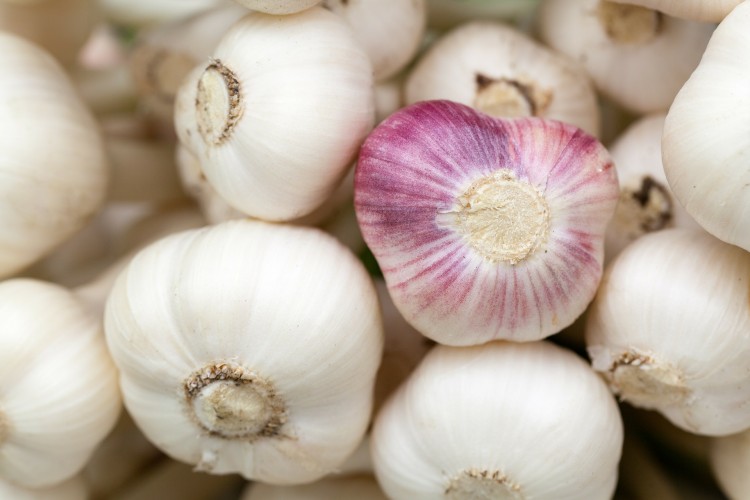
You will need:
- An onion.
- Two to four cloves of garlic
- A sieve or cheesecloth
Directions:
- Chop garlic cloves and onions finely and crush the chopped pieces.
- Place in cheesecloth or on a sieve to squeeze out the juice.
- Dab this juice over the affected areas.
- Leave it on until dry.
- Wipe off and wash the area with warm water.
- Repeat this process daily for best results.
Japanese Honeysuckle
Japanese honeysuckle, also known as Lonicera japonica, is widely used in traditional Japanese medicine for treatment of various health conditions like fever, flu, inflammation, boils, sores and bacterial and viral infections. It acts as a potent antibiotic due to its active ingredient, chlorogenic acid. Luteolin is also present in it which behaves as an antioxidant and anti-inflammatory agent and helps cure boils and reduces pain. Honeysuckle flowers, leaves and stems are used in various forms like a tincture, tea, infusion, etc.
You will require:
- Fifteen to thirty grams of dried honeysuckle stems.
- 600 ml of water.
- A cheesecloth or sieve.
Directions:
- Put the dried honeysuckle stems in a jar.
- Pour water on them.
- Steep overnight.
- Strain the liquid using a sieve or cheesecloth.
- Apply the liquid over the affected area.
- Allow it to dry on its own.
- Rinse the area with warm water and pat it dry gently.
- Repeat this process regularly for achieving best results.
- You can also use this liquid to wash the affected area several times a day.
Parsley
Parsley helps dry up boils and bursts them quickly without spreading infection because it has antioxidant, anti-fungal and antiseptic properties.
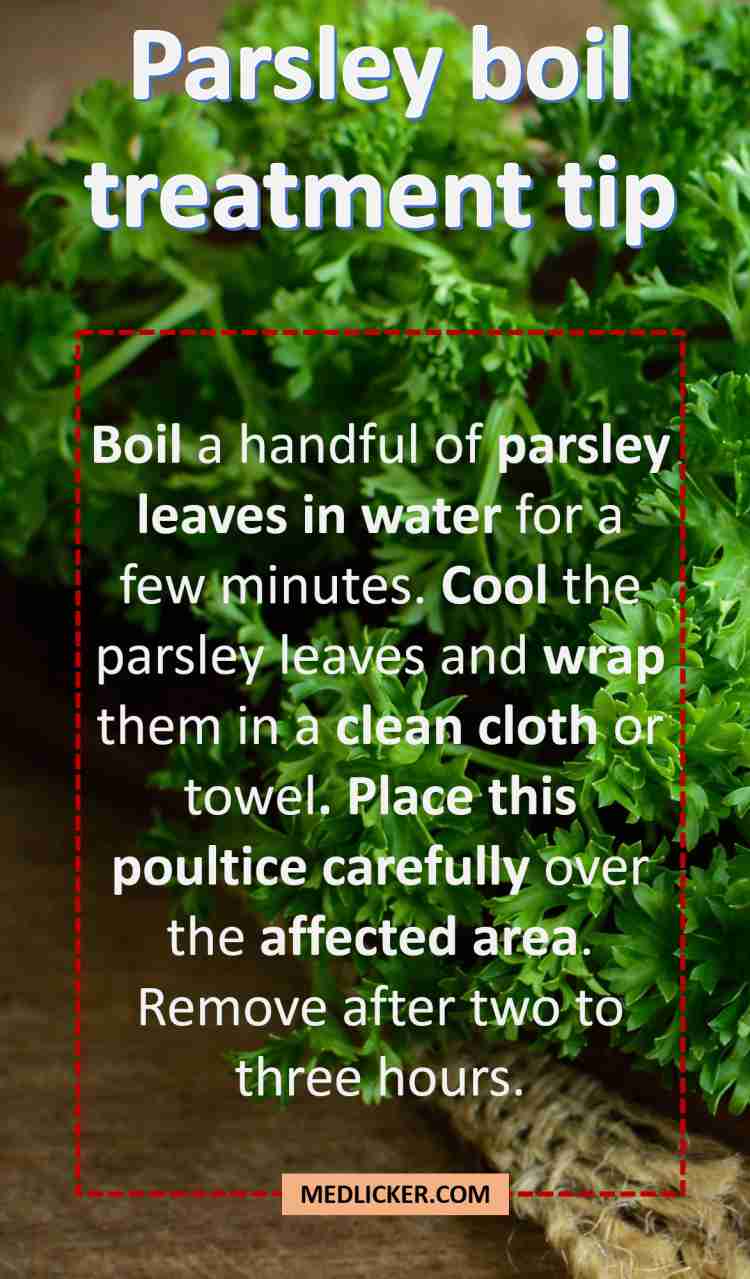
If you apply parsley regularly, it will soothe broken or inflamed skin.
You will need:
- Handful of parsley leaves
- Some water
- A clean cloth
Process:
- Boil parsley leaves in water for a few minutes.
- Cool them and wrap them in a clean cloth and place this poultice gingerly over the affected area.
- Remove it after two to three hours.
- Repeat regularly to cure boils.
Burdock root
Burdock root or Arctium lapa purifies blood and it also has antibiotic properties that help treat boils by flushing out toxic substances and preventing inflammation and infection.
Note: Women who are pregnant or nursing mothers or individuals suffering from diabetes or cardiovascular diseases should not use this herbal remedy.
You will require:
- One tablespoon of dried burdock root or some fresh burdock root.
- Three cups of water
- A pot
Process:
- If you are using fresh burdock root, scrape it clean with a knife.
- Cut up and boil the root in water for half an hour.
- Steep this mixture for 15 – 20 minutes.
- Strain it.
- Drink only one cup at a time because it has diuretic properties.
- You can also use this mixture to wash boils 3 – 4 times a day.
Nutmeg
Nutmeg stimulates blood supply which helps fight bacteria and it also has anti-inflammatory properties that reduce the pain and swelling caused by boils.
You will need:
- Half a teaspoon of ground nutmeg
- A cup of hot water or milk
Directions:
- Mix ground nutmeg in hot milk or water.
- Stir it well and drink this mixture regularly to get relief from boils.
Castor oil
Castor oil is extracted from the seeds of the castor plant known by scientists as Ricinus Communis and is a popular ingredient in traditional Indian ayurvedic medicine for treating several skin conditions and chronic pain.
Ricinoleic, an anti-inflammatory substance, is present in castor oil and it also has antibacterial, antiviral and antifungal properties, making it a useful remedy for treating boils.
You will need:
- Castor oil
- Some cotton
- A clean bandage or gauze
Instructions:
- Dab a few drops of castor oil on the affected area using a clean wad of cotton.
- Cover it with a clean bandage or gauze.
- Leave it on overnight or for at least three to four hours.
- Repeat regularly for best results.
Betel leaves
Betel leaves have several therapeutic traits and are often used to treat many health and skin problems. Tannins and other essential oils are present in betel leaves that help prevent infection and repair the skin. They also have antiseptic, antiprotozoal, antifungal, and bactericidal qualities that dry the pus from boils and clear toxins rapidly.
Method #1:
You will need:
- A betel leaf
- Some castor oil
- A clean bandage or cloth
Instructions:
- Apply castor layer over the leaf and warm the leaf.
- Place the warm leaf on the area with boils.
- Cover it with a clean bandage or cloth.
- Leave it on for two hours.
- Replace old betel leaf with a fresh oil applied warm leaf and leave it on for another 2 hours.
- Repeat this process regularly for obtaining best results.
Method #2:
You will need:
- Two to four betel leaves.
- Half a cup of water
- A bandage or gauze
Instructions:
- Shred betel leaves into small pieces and boil in hot water for about ten minutes.
- When they cool down, mash the leaves into a paste.
- Apply this paste over boils and cover with a clean bandage.
- Leave the paste on for 2 hours.
- Reapply it and allow it to sit for another 2 hours.
- Repeat this process two times everyday.
Apple cider vinegar
Apple cider vinegar is a natural antiseptic agent and disinfectant that efficiently cleanses the infected material from boils once they begin to drain.
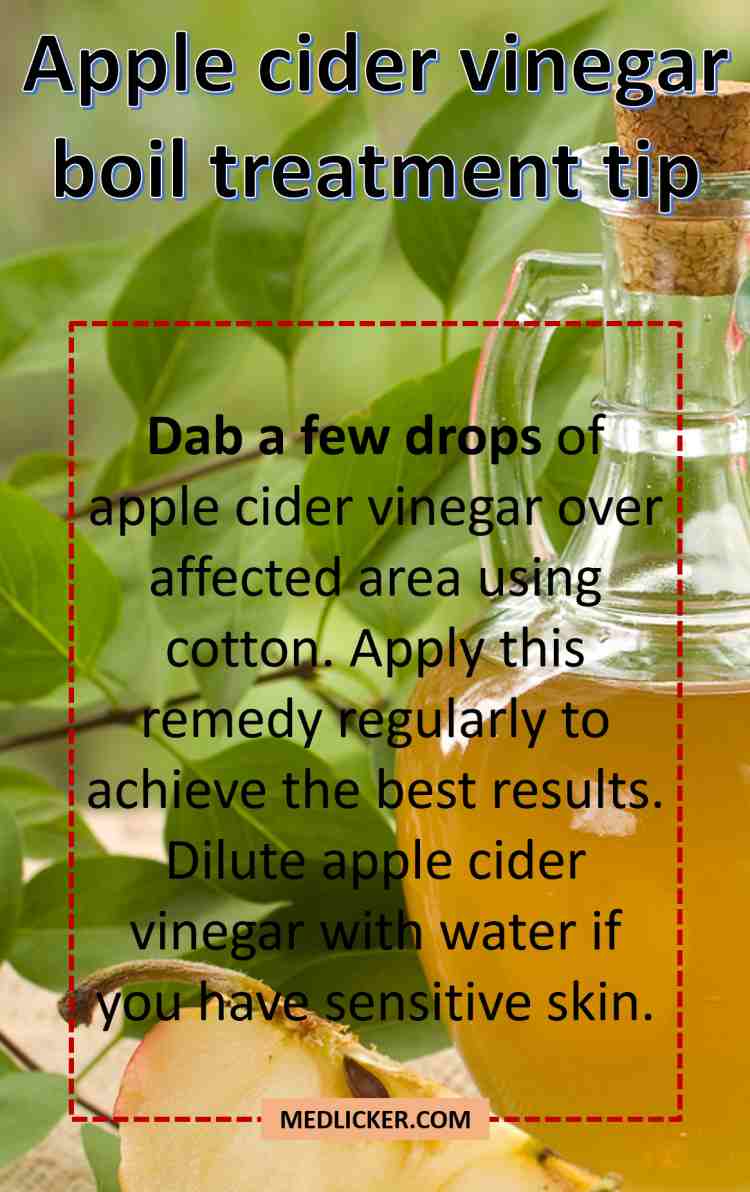
It is also an anti-inflammatory agent and helps cure pain and inflammation while neutralizing pH level of skin to heal it quickly.
You will need:
- Some apple cider vinegar
- Cotton
Instructions:
- Dab a few drops of apple cider vinegar over affected area using cotton.
- Apply this remedy regularly to achieve the best results.
Note: Dilute apple cider vinegar with water if you have sensitive skin.
Jelly jar
Application of suction to area affected by boils will help solve the problem. It elevates blood flow in the affected area and increases pressure to draw out pus.
You will need:
- A bowl
- A cup
- Some water
- Tongs
Directions:
- Pour some hot water into a bowl.
- Place a cup in this water until it gets warm.
- Place the warm cup over boils.
- When the pus comes up, gently draw it out and wipe it off.
- Repeat this process regularly for best results.
Eucalyptus oil
This wonderful boil remedy has antibacterial, antiviral and disinfectant traits that soothe skin and reduce pain and irritation. Slippery elm is also useful for treating boils.
You will need:
- Three drops of eucalyptus oil
- Twenty grams of powdered slippery elm
- Boiling water
Process:
- Combine eucalyptus oil, powdered slippery elm in boiling water to prepare a paste.
- Apply this paste on affected area.
- Allow it to dry.
- Repeat this process twice or thrice daily to heal boils.
Basil and Asafetida
Basil has antiseptic, bactericidal and anti-inflammatory qualities that give the immune system a much-needed boost and reduce inflammation. When combined with asafetida, it is a great remedy for treating boils.
You will require:
- Handful of fresh basil leaves
- A small piece of ginger
- A pinch of asafetida
Directions:
- Blend together a handful of basil leaves, a pinch of asafetida and some ginger to prepare a paste.
- Apply this paste over affected skin area.
- Repeat this process regularly for obtaining best results.
Diet
Boils appear due to attack of bacteria when immune system is weak. A healthy diet will help boost your immunity and ward off bacteria and germs from your system.
You should add these items to your diet:
- Fresh fruits
- Green leafy veggies
- Vitamin C rich foods for example citrus fruits, berries, melons, kiwi, peas, peppers, pineapple, sweet potatoes, spinach, winter squash and tomatoes. Required daily intake amount is 3000 mg per day to cure bacterial infection.
- Vitamin E rich food items for example as almonds, pine nuts, raw seeds, mustard green, Swiss chard, plant oils, kale, avocado, hazelnut, olives, parsley, herbs and wheat.
- Foods that are a rich source of vitamin A such as lettuce, carrots, cod liver oil, sweet potatoes, paprika, whole milk, turkey, mango, liver, kale, dried apricots, cantaloupe, dried marjoram, oatmeal, papaya, and peaches.
- Foods plentiful in Phytonutrients such as barley, wheat grass, edible algae like chlorella and kelp, and chicory root.
- Foods that detoxify liver for example artichoke, dandelion greens, kelp, peppermint, and milk thistle.
- Zinc-rich foods for example cocoa, beans, dark chocolate, pork, mushrooms, chicken, seafood, nuts and toasted wheat germ.
- Foods rich in vitamin-B complex.
- Astralagus tea.
Avoid these things in your diet:
- Sugary and fatty foods such as chocolates, cakes, and white bread.
- Fizzy drinks and caffeinated beverages such as coffee and black tea.
Things to remember
Wash your hands regularly and use a hand sanitizer whenever needed.
Avoid sharing clothes, blankets, bedding items and towels. Keep your towels and clothes clean and dry.
Exfoliate your skin regularly. This will help clear sweat ducts and prevent the appearance of boils.
Never poke or squeeze a boil because the pus might infect surrounding areas as well.
Don’t purchase any over-the-counter medicines that claim to draw pus from your boils. They will aggravate the problem.
Wash the boil and its surrounding area gently every day using a sponge or soft washcloth to avoid any more bacterial invasion or oil build-up. Pat it gently dry.
Always clean cuts and wounds immediately to kill bacteria and cover them with a bandage so that they heal properly.
Colloidal silver cream is a potent, natural disinfectant so apply it two times daily on affected skin area.
Dab anti-bacterial creams or ointments on affected area and cover it with a clean bandage or gauze. Allow it to drain on its own.
Roll pork or bacon in salt. Place the chunk of meat between two pieces of cloth and place it over the affected area. Salt dries boils completely by drying out pus from them.
Application of boiled egg whites has also been known to be helpful.
Use figwort or marshmallow leaf as a bandage or cover to heal boils faster.
Drink warm water to flush out bacteria from your system.
Boil fenugreek seeds in water and prepare their paste. Apply this paste to achieve relief from boils.
Use calendula ointment, an antibacterial agent, to alleviate inflammation of the skin caused by boils.
Contact your doctor or dermatologist at once if you experience the severity of symptoms such as fever and pain.
| Written by: | Michal Vilímovský (EN) |
|---|---|
| Education: | Physician |
| Article resources: | See numbered references within the article. |
| Image resources: | |
| Published: | August 19, 2016 at 12:25 AM |
| Next scheduled update: | August 19, 2018 at 12:25 AM |
Get more articles like this in your inbox
Sign up for our daily mail and get the best evidence based health, nutrition and beauty articles on the web.


Ache in left arm that you should not ignore
Alkaline water dangers: why you should not drink it
How to Avoid Sleepiness While Studying?
23 Foods That Increase Leptin Sensitivity
Low dopamine (e.g. dopamine deficiency): causes, symptoms, diagnosis and treatment options
Swollen taste buds: the ultimate guide to causes, symptoms and treatment
Thin endometrial lining: causes, symptoms, diagnosis and treatment
Pimples inside nose: the complete guide
Holes in tonsils: definition, symptoms, treatment and prevention
How to deal with an ingrown hair cyst
Allegra vs. Zyrtec vs. Claritin
Allergy to penicillin and alternative antibiotics
How to get rid of phlegm (excessive mucus) in throat? Detailed guide to medical and home remedies, symptoms and causes
What causes stomach ache after meals?
Liver blood test results explained